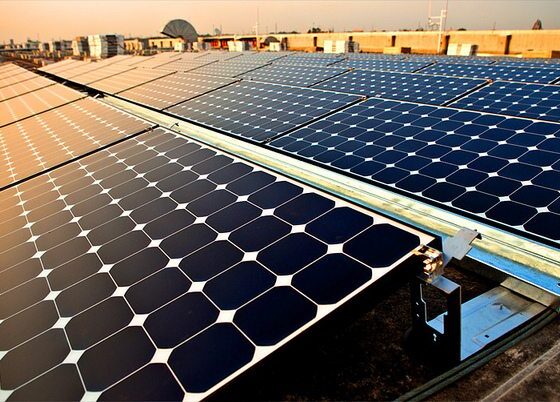

News
Analysis finds 50KW rooftop solar provides best return for investors
Renewable energy projects can offer significant investment opportunities for developers, investors and landowners, with recent high profile investors including Bill Gates who has announced $2 billion investment in green energy technology and research, and The National Trust’s announcement for £30 million investment in renewable energy to heat and power more of the historic places that it looks after.
However with the sector changing fast in terms of the support mechanisms, the question is: which onshore technology provides the best investor returns?
An assessment by property consultancy Carter Jonas’ specialist Energy team has looked at each technology against key investment criteria to produce its annual Energy Index 2015. Across Wind, Solar Photovoltaic, Biomass Heating, Anaerobic Digestion, Hydroelectric, and Ground-source Heat Pumps, it has considered factors such as development costs, value versus development costs, planning approval, development timescale and Internal Rate of Return (IRR).
It has also taken into account the recent Department of Energy and Climate Change (DECC)’s proposals to remove support for on-shore wind and solar farms under the Renewable Obligation (RO) from April 2016, factors which Carter Jonas believes have presented a significant setback to the UK’s renewable industry.
A 50kW PV Rooftop project is considered the most attractive technology from an investment perspective. Ranked first on Carter Jonas’ risk benefit table, whilst it does not deliver the highest IRR, it is considered relatively low risk and scores well in most categories.
A 5MW Solar PV Park or 10MW Wind Farm have historically been some of the most attractive technologies for investors, but were ranked eighth and ninth respectively. However due to the loss of support under the Renewable Obligation, this has significantly reduced the projected IRR’s for both technologies, thereby extinguishing the potential development value of the sites once consented, and making them relatively unattractive.
Biomass is also an attractive investment, despite recent cuts to the Renewable Heat Incentive (RHI), it was ranked second. It is important to note that small scale (under 200kW) biomass is financially challenging due to the lower RHI, and the report considers a system greater than 200kW. In particular, Biomass is an excellent opportunity for properties off the gas grid.
A 500kW Wind Turbine is ranked highly at third as it still delivers the highest return on investment for the right site. However Wind has a lower planning approval rate and also low development costs’ score, reflecting the high development costs and risks associated with securing planning for sites.
A 1MW Waste Anaerobic Digestion (AD) and a 500 kW Farm AD were ranked fourth and sixth respectively as operation and maintenance are higher than other renewable energy technologies, and there is volatility of financial support mechanisms, particularly the reductions in the biomethane injection tariff (RHI).
Ground-Source Heat Pumps (GSHP) are ranked fifth, despite a fair IRR and low risk at planning. This is because, relative to the size of the technology, GSHPs require more investment and a longer timeframe to develop, with less significant income potential for an investor.
A 500 kW Hydro was ranked seventh as projects can require extensive environmental and ecological studies to obtain consent, the planning process can be complex and lengthy, and costs and resource income can vary significantly between sites.
Andrew Watkin, head of energy and marine, Carter Jonas said: “The UK has a fantastic pool of natural resources and we continue to call for the Government to get behind the renewable sector.
“When considering renewable energy investment opportunities, it is prudent to consider the risks against the potential benefits. To help our clients understand their options when it comes to onshore renewable energy, we grouped the various factors together to show the relative risk versus benefit.
“500kW Wind has the highest benefit but also has very high risk, while a 50kW Solar Scheme also has good benefit with significantly less risk. Due to recent changes to incentives, large solar and wind farms now offer investors a much lower benefit.
“Our research has identified the most attractive renewable technology opportunities available, at the present time, according to key investment factors. However each opportunity will be driven by site specific circumstances and we would always recommend careful assessment and due diligence of individual projects prior to any investment.”
Andrew Watkin added: “The recent proposals by the DECC have presented a significant blow to the renewable industry in the UK, particularly at a time where projections were that solar would be subsidy free by 2020, based on previous projected investment. As an investment, renewable projects are generally not mature enough to withstand a complete removal of any support mechanism.
“For renewable energy to be successful without support, several critical changes would need to occur within the industry: reduced costs of installation, reduced cost of grid connection, and increased value for sale of electricity.
“Overall, the industry needs support from the Government, not opposition with continual regulatory, planning and financial barriers driving investment away from the sector. Needless to say, the best projects will remain the sites with the best resource: solar irradiation, wind speed, and so forth, and the lowest development cost.”


 Features9 months ago
Features9 months agoWhat is the Eco-Friendliest Option to Wash Your Dishes?

 Environment12 months ago
Environment12 months agoBuilding a Career in Green Construction: Tips and Insights

 News11 months ago
News11 months ago5 Ways Fleet Maintenance Software Can Help Businesses Be More Eco-Friendly

 Features10 months ago
Features10 months agoAddressing Pressing Ethical Concerns with Crypto Exchanges

















